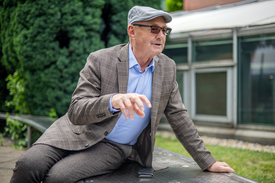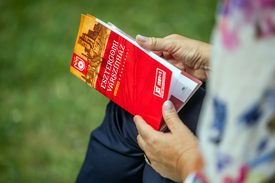
Photo: Democrata/Tibor Vermes
– Esztergom Castle Theatre operates as an open-air theatre at the southern end of the castle, at the so-called Buda Tower. Next to it is the Basilica, the largest cathedral in our country. To what extent does the spirit of the place determine the work of the theatre and the performances?
“Genius locations really work.” When someone sees this geographical environment, and sees the Castle Hill, their imagination immediately starts. While Esztergom Church is the main cathedral of the Hungarian Catholic Church, the Royal Castle is, we can safely say, the cradle of our state. This comes with responsibility and commitment, and you can’t give any performance there!
“And I think you can’t have any theatre!” In the world of theatre, the Esztergom Castle Theatre was one of the first to offer Hungarian theatre actors outside the borders the opportunity to present themselves. Is this tradition still alive today?
– So much so that today there is hardly a Hungarian theatre in the Carpathian Basin that has not performed in Esztergom! But among them are the Csiky Gergely State Hungarian Theatre in Temesvár and the Jókai Theatre in Komárom, which are two theatres that constantly return. Sometimes people from across the border bring their own plays, but there are also times when we organize joint performances with them. This year, for example, the musical drama Pengetangó by Erny Ferebis, a contemporary composer from Vojvodina, will be presented together with the Gyulai Castle Theatre and the Arad Chamber Theatre on July 5. These performances are also particularly interesting because the audience can experience different styles of theatre across the border compared to those in the motherland.
“What do you appear in?”
– Since Hungarians across the border live with people from another country, this inevitably shows in their use of language, the rhythm and emphasis of their language. The same is what characterizes their acting style, which results in a very interesting combination. This is especially true if the director is not Hungarian, and I will give an example! The famous Romanian director Silviu Porcarietti regularly works at the Hungarian Csiky Gergely State Theatre in Timisoara. A few years ago, The Tragedy of Man was staged under his direction, where the stylistic features and way of thinking that characterize Romanian theatre can be fully experienced. But I also have my own example, as I often play at the Jokai Theatre in Komárom, where the actor and director Martin Hopa is often invited. I worked with him on Miroslav Krlega's drama The Glembay House, in which I played Ignjat Glembay, a private advisor and banker. It was an unforgettable rehearsal process and then an unforgettable performance, where the performance included everything that characterizes modern Slovak acting today. In other words, it was not a natural play, but a very expressive and intense performance, where the actors had to play the role of “elevating” a little from the ground. Thank God I was introduced to this kind of acting!

Photo: Democrata/Tibor Vermes
– Can we consider the presence of Hungarian theatres across borders as a kind of mission?
– Definitely, because the cross-border audience and the local audience can meet through the theatre. It happened that people from Nagyvárad came to us with such a good performance that a bus full of people travelled to Transylvania just to see them at home, on their own stage. In other words, theatre plays a role in shaping identity on the one hand, and on the other hand it also plays an economic and touristic development role.
– He was the artistic director and stage manager almost from the beginning, since 1996. How did you get to Esztergom?
– Our family has been from Esztergom for generations, so I have always had a strong connection to the city. I was just a member of the Csokonai National Theatre in Debrecen when our summer playground in Tata ceased to exist. Of course, it immediately occurred to me that there was a summer theatre operating on the Várhegy side of Esztergom, so I promised to ask about it when I got back home. The city administration was also happy about this inquiry, so we surveyed and mapped everything out together with the people of Debrecen, and then presented a five-year program plan. Then suddenly we received a letter from Esztergom: due to financial difficulties, they cancelled the cooperation. Shortly after, we were surprised to see the news on TV about the opening of the Esztergom Castle Theatre. I felt ashamed until two or three years later, in 1992, they approached me and apologized profusely, and since then I have been managing the affairs of the theatre as artistic director, and from 1996 as director.
– We started talking about the spirit of the place. But what can the audience expect this season?
– It is certainly important that we want to renew our activity on stage and in the auditorium. That is why the season will start on June 26 and 27 with the examination performances of the University of Dramatic and Film Arts, Timbévy and Chicago. On July 12, Csaba Pindroch presents his two-person play Mr. and Mrs. with his wife, Linda Fereps, and the Hungarian Drama Theatre of the Subcarpathian Region, which regularly returns to Beregsászás, presents Gogol's House Fire Spectator on July 20. It is certainly worth noting that we will set up a large stage in front of the Esztergom Church, where Cosma Orsi will play with the Mendelssohn Chamber Orchestra from Fishbrem, and Gergely Pojany, the Kossuth Prize-winning pianist, will play on his piano. In August. As an accompanying event to the theatrical season, in cooperation with the Lilliput troupe from the Szigliget Theater in Nagyvárad, we are organizing for the 24th time this year the Creative Art Camp for the Little Ones, known to the locals as the “Puppet Camp”.
– The Esztergom Castle Theatre has been operating continuously for 35 years this year. In addition to funding from state and local governments, do they also have supporters from economic actors?
– There are people who are always by our side, like Neuzer, the leading bicycle manufacturer in Hungary, or the Suzuki car factory. But in general it can be said that it is very difficult to convince economic actors to support culture. Our situation is not always ideal, we have better and worse seasons, that's it. Even if the performance is lower, we always manage somehow. There was a year when the training and performance fees from my acting career went directly into the Castle Theatre's coffers. This was also necessary for these 35 years to be truly continuous.






